New Technology
Several new forms of technology , including electric generators, telephones, and automobiles, led to a boom in consumer appliances. In doing so, it drastically changed the way people lived.
Electricity
In earlier times people knew there were natural forms of electricity, such as static electricity. Benjamin Franklin proved that lightning contained electricity by flying a kite with an iron key attached during a thunderstorm.
An English scientist, Michael Faraday, learned how to generate electricity in 1831. But it was not until 1879 that Thomas Edison and Joseph Swan came up with a system to generate electricity through a light bulb.
Before this, gas was used to light fixtures in homes and businesses. It wasn’t the best solution as burning gas emits black soot which got all over everything. Electric lights removed the soot problem, and provided better illumination.
Edison and others invented ways to generate the electricity and then to deliver it to homes and businesses. By 1882 an electrical station in New York City was supplying electricity to nearby homes and businesses.
Electricity production created a new industry--electrical appliances. Once a home or business was wired for electricity, then almost an endless list of items could be developed to use it. This included electric irons, fans, motors, refrigerators, and stoves.
New electrical appliances were invented. Vacuum cleaners began to replace brooms and carpet beaters with the introduction of the Electrolux in 1921. Schick began to sell the first electric shavers in 1923. A spin dryer to dry clothes was marketed during the 1920s. As the icebox was replaced by electric refrigerators, Birdseye introduced the idea of frozen foods purchased at the grocery store.
A majority of people living in cities had electricity in their homes by 1930. Only ten percent of rural area homes had electricity. In Tennessee, the introduction of the Tennessee Valley Authority helped bring electricity to these rural areas in the 1930s.
Telephones
Probably nothing has changed the ability of people to communicate with each other as much as the telephone. Before the telephone, the only way to find out what your sister in another state was doing was to write a letter.
Alexander Graham Bell had been working on improving telegraph equipment in the 1870s when he realized that he could transmit a person’s voice over wire. With help from Thomas Watson, Bell finally transmitted his voice over wire in 1875. Within two years, the first private lines connecting businesses had been placed in service.
The first telephones had a generator and a crank. The caller turned the crank to call the switchboard operator. When the operator answered, the caller told her whom he was calling. By connecting wires on the switchboard, the operator would connect the two people.
At first telephones were expensive. They were used mainly by businessmen, doctors, and druggists. When Bell’s patents ran out in 1893, any company could use the technology to develop their own systems. New companies started marketing telephones to residential customers. From 266,000 users in 1893, telephone usage grew to nearly 1.4 million users in 1900. In 1930 there were 20 million homes with telephones.
Some local people, unhappy with high rates, organized their own telephone companies. In 1910 people in Liberty, Tennessee, started their own phone company. It cost $25 to join plus the cost of putting up wires and posts. The annual subscription rate was $7.
At first, businesses, like drug stores, allowed people to use their business telephone for free. But they soon got tired of lines of people waiting to use the telephone and getting in the way of customers. By 1900, pay phones, requiring a nickel, were common.
Most homes had party lines. This meant you shared the same telephone wire with two, three, or four other homes. This allowed the phone company to charge less—making a telephone more affordable. Each home had a distinctive ring. So if the telephone rang, people would stop and listen to see if it was a call for them.
If you had a party line, you couldn’t use the telephone if your neighbor was talking. And the only way to find out if he was on the telephone, was to pick up and listen. Of course, you could also listen to their phone conversation!
In the beginning, people had to figure out how to use the telephone. Many people considered saying “hello” as impolite. AT&T, a telephone company, even recommended in 1910 that callers begin their phone conversation by saying “Mr. Wood wishes to talk with Mr. White.” Some parents considered telephone use out-of-bounds for their children.
Automobiles
The automobile was developed from the bicycle. Bicycling was a popular recreational sport in the late 1800s. When the technology for building an automobile was available, bicycle makers became some of the earliest automobile makers. These first cars were generally expensive and were sold to rich people interested in driving or touring to different places.
Later when prices dropped, people started using automobiles for practical reasons. They drove to work. Farmers hauled their goods to market. Doctors drove to patients’ houses.
Sales of automobiles really increased when Henry Ford started selling the Model T, a cheap, but good automobile. Prices continued to drop as the technology enabled manufacturers to build cars quicker and cheaper. The Model T, which sold for $825 in 1908, only cost $260 in 1925. By 1930, almost sixty percent of Americans had some sort of automobile or truck.
Picture Credits:
- Photograph of the “Chattanooga Electric Light Company.” This photo was taken in 1894 on East 6th Street. It shows 24 men, probably company employees, along with four children in front of the building. Chattanooga-Hamilton County Bicentennial Library.
- Photograph showing the inaugural run of Nashville’s first electric streetcar. This photo was taken at 16th Avenue and Broad in 1889. It shows a group of people standing in and around the decorated streetcars. Tennessee State Library and Archives.
- Photograph of the Eatherly family in an automobile. This photo was taken in Lebanon, Tennessee in 1915. Tennessee State Library and Archives.
- Photograph from a scrapbook page entitled, “The Gang.” This photo was taken in Nashville in the summer of 1928. It shows a group of young African American female students sitting on an automobile. Tennessee State Library and Archives.
- Photograph showing Leland Hume talking on a telephone. This photo was taken in Nashville in 1898. It shows Hume talking on a wall-mounted telephone. Tennessee State Library and Archives.
- Photograph showing of a switchboard operator. This photo was taken in 1905 in Weakley County, Tennessee. It shows a female operator wearing her headset and sitting in front of a switchboard. Tennessee State Library and Archives.
- Photograph showing downtown Nashville at night. This photo was taken on Union Street looking toward 5th Avenue. It features as numerous pedestrians walking as well as electric lines, carriages, and lights. Tennessee State Library and Archives.
- Photograph of Morristown, Tennessee. This photo was taken in January of 1912. It shows a street scene with horses and carriages as well as businesses. Tennessee State Library and Archives.
- Photograph of the Tennessee Centennial Exposition at night. This photo was taken in Nashville in 1897. It shows the electric street lights and lamps of the agricultural building during the exposition. Tennessee State Library and Archives.
Confronting the Modern Era >> Life in Tennessee >> How They Lived >> New Technology
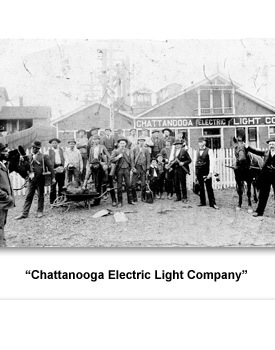
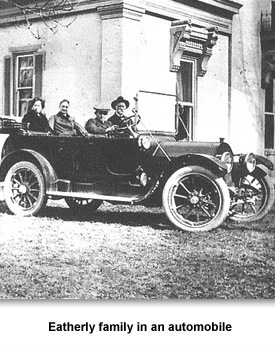
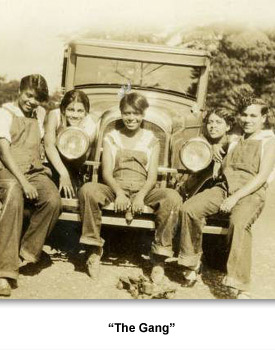
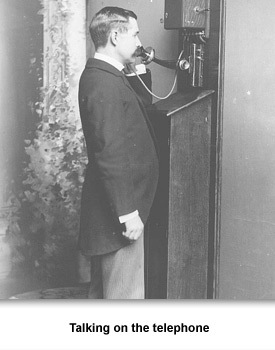
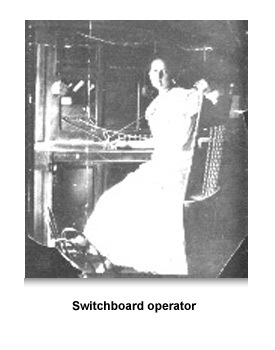
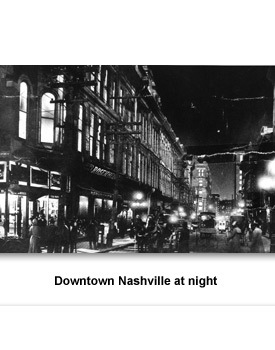
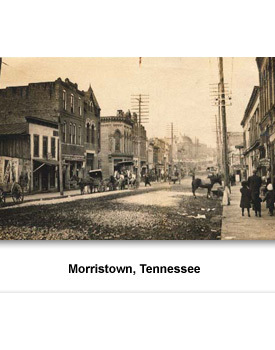
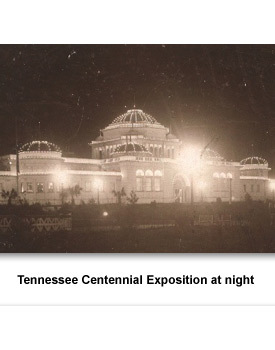
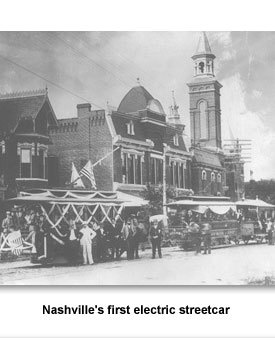
 Sponsored by: National Endowment for the Humanities
Sponsored by: National Endowment for the Humanities